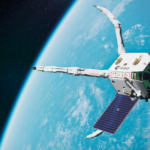An emerging set of in-orbit services aimed at increasing flexibility, sustainability, and safety for satellite operators from launch to end of life, could materialise into a space logistics ecosystem featuring frequent service interactions between spacecraft in orbit, according to leading space consultancy and market analysis firm Euroconsult in its recently published ‘Space Logistics Market’ report (2nd edition).
The report covers six market verticals (involving over 50 suppliers over the world) including Access to Space, Last Mile Delivery (LMD), Satellite Life Extension, Active Debris Removal (ADR), On-orbit Assembly and Manufacturing (OOAM) and Space Situational Awareness (SSA), all of which stand at different stages of maturity. It maps out current offerings and those coming to the market, delving into the trends shaping them, and forecasting demand over the next decade.
Space sustainability
Euroconsult highlights the growing importance of space sustainability, as global government agencies increasingly recognize the need to promote responsible behaviours in space and mitigate the multiplication of debris. The SSA market is the first beneficiary of this driver and is estimated to reach $1.8B in revenue over 2023 to 2032 in a baseline scenario, driven by growing orbital congestion. At the opposite end, the Last Mile Delivery market is estimated to be over ten times smaller and the satellite Life-Extension market, two times smaller.
Due to low service maturity overall, government agencies are expected to play a key role in market building by seeding technology development financially to increase TRL, providing anchor demand to enable demonstrations and service maturing, as well as defining regulatory frameworks to encourage service adoption and promoting standardization.
Space logistics
Space logistics will likely leverage the rapid structural changes occurring in the access to space industry, marked by the transition to a new generation of GTO-capable launchers, growing competition in all segments of the market, and the introduction of super heavy, fully reusable launchers.
The report forecasts launch rates for each launcher category, confronting demand to supplier capabilities (including upcoming super heavy launchers) and anticipates up to 220 launches per year in the most optimistic scenario while expecting a threefold launch price decrease over the decade, owing to new design-to-cost value propositions and to the progress of reusability.
Subscribe to the FINN weekly newsletter

